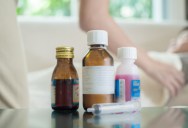Researchers Are Working To Ensure Children’s Medication Is Safer In The Future And To Avoid “Off-Label” Dosing

In recent years we’ve learned that things like crash test dummies are only created to make crashes safer for male victims, and are never made to mimic female or children’s bodies.
It turns out that using adult males as the default is a common practice in the pharmaceutical field, too, which means much of the medication that’s marketed to kids hasn’t been fully vetted.
Also, why there’s a frustrating lack of treatment options beyond your basic painkillers.
When drugs get approved for use, it’s almost always because it has cleared hurdles and been declared safe for adults. These are drugs for mental health disorders, cancer, rare diseases, and a bunch of other conditions that are more mundane.
None of those drugs, though, are for children – and pediatricians like Mark Turner are getting increasingly frustrated at not being able to help their patients in the same ways.

If they want to use drugs for kids, from newborns to older children, they have to prescribe them “off-label,” which means using them differently than what’s printed on the package.
This 10-year study looked at 1.74 billion outpatient visits at pediatric facilities. They found that around 40% of those visits resulted in an off-label prescription being handed out.
Antihistamines are the most common, followed by antibiotics and antidepressants. As for the latter, many doctors, like Daniel Horton (one of the authors), say there is less evidence that supports the idea that antidepressants benefit children.
Popular antidepressants, like Trazodone, Citalopram, and Wellbutrin have not been approved to treat any condition in children, and the list of potential side effects is long. Other drugs, like Zoloft, is only approved to treat OCD in children, not depression, and potential side effects are one of the reasons for that, too.
Horton’s paper puts forth concerns with off-label ordering, like a greater room for error or the potential for surprises. He says 1-2% of children react badly to FDA-approved medicines, and when they’re given off-label, that percentage is half a point higher. Many of the risks are small and easily managed, but some of them are not.
One of the drug types where this problem crops up frequently are with antipsychotics, which are often given to young people who have behavioral issues. Studies suggest that kids are more likely to become aggressive and to struggle with suicidal thoughts while taking these off-label.

Although the vast majority of these drugs seem to be safe, even when used differently than approved, but most believe the lack of proper testing could always come back to bite kids in the end. Side effects can be different or more severe, or the medications might be less effective in kids.
One reason this is all so difficult is that children’s bodies and brains are still developing, and often their organs function differently than they do in adulthood. So, what might work for an infant wouldn’t work for a third grader wouldn’t work for a high schooler, and vice versa. Ideally, all developmental stages would be represented in a clinical trial.
Nearly all of what babies receive in the neonatal intensive care unit has not been officially tested or cleared for babies their size and gestational age. Everyone seems to wish there were more trials that included children, but there are practical and financial reasons why that’s unlikely to happen.
In the gap, The American Academy of Pediatrics gets together to create dosing guidelines by expert consensus. This will include looking at literature, input from regulators or world organizations, along with their combined clinical expertise.
While good and thorough, it’s not the same as meeting the expectations that are set before medications can be prescribed to adults.

Children have historically been excluded from medical trials, since they are considered vulnerable and at-risk, and also because they’re not able to consent. Now, most scientists believe that should change since clinical trials are appropriately safe.
Not only that, but drugs that have been tested and found to actually work for kids would be great.
And this all is obviously a much higher-stakes game for parents of kids with rare or terminal diseases. They could have to leave the country to get access to some pediatric drugs in experimental stages, because the US still balks at enrolling kids in these trials.
As with most things in this world, a lot of this comes down to money – money to be spent and the potential for money to be made, and the bottom line is that more adults than children require regular medication. And if the drug companies don’t think they’ll be able to sell a bunch of something, they don’t have much interest in research or trials.
All drugs that are created to treat rarer diseases face the same hurdles, and since fewer children than adults get sick, it’s even harder to find willing test subjects to include in the first place.

Congress is trying to push for change, with both the Best Pharmaceuticals for Children Act and the Pediatric Research Equity Act, but even those are struggling to really move the needle.
One reason is that the incentives just aren’t good enough, and once there’s a lapsed patent and the drug is offered as a generic, they don’t apply at all.
Which is all to say, the medical community seems to be at a bit of a loss, and a bit at odds with the pharmaceutical industry when it comes to spending the time and money that would be required to make sure these drugs were safe for children.
Make of that what you will.
Thought that was fascinating? Here’s another story you might like: Why You’ll Never See A Great White Shark In An Aquarium

Sign up to get our BEST stories of the week straight to your inbox.




